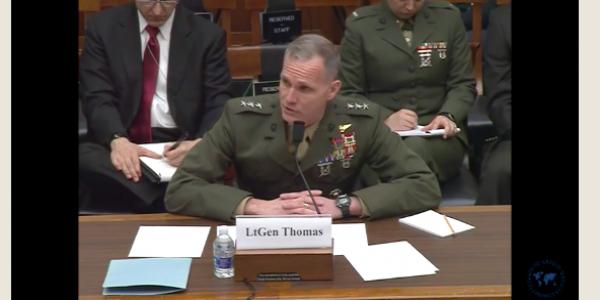U.S. Marine Corps Looking to Stand Up Information Warfare MEF
With a little more financial backing, the U.S. Marine Corps is primed to grow its force in three critical areas to meet the threats of the future: cyber, electronic warfare (EW) and intelligence.
The nation’s expeditionary service is creating what Commandant Gen. Robert Neller, USMC, has called a Marine Expeditionary Force (MEF) information group—a critical component that encompasses those three key warfare domains, Lt. Gen. Gary Thomas, USMC, deputy commandant for Programs and Resources, told members of the U.S. House Armed Services Tactical Air and Land Forces Subcommittee.
“Our perspective is now broadening in terms of additional capabilities that we would need when [troops are] going force-on-force and being able to counter some of the [electronic warfare] capabilities that our adversaries are developing,” Gen. Thomas said.
The Corps wants to grow its active duty force by roughly 3,000 Marines, for a total end strength of 185,000, he said, with a good amount of growth taking place in those three critical information group areas, he said. “We’re also seeing the nexus of cyber and EW, and it’s about providing the equipment that allows you to do that, but also now, the organization that gives you that capability as well,” he said of the creation of this MEF information group.
Gen. Thomas also addressed the adverse effects that sequestration and years of relying on budgetary continuing resolutions have had on the Marine Corps’ ability to modernize its current force and be ready and capable to engage in emerging threats.
Sequestration has seriously hampered the Corps’ investment in modernization, which has slumped to a low of 7 percent of its budget. “This is a dangerous trend that we must reverse for the nation’s expeditionary force in readiness,” he told lawmakers on Friday.
Corps leaders anticipate increasing the investment portion to about 10 percent in fiscal year 2018, with an eventual goal of 15 percent, Gen. Thomas said.
The Corps’ seemingly disproportionate investments in aviation versus ground equipment concerned Rep. Niki Tsongas (D-MA). “For many years, the Marine Corps has requested and received vastly more funding for procuring aircraft as compared to ground equipment,” she said. “While the Marine Corps certainly has a need for aircraft of many types, the ratio of spending on aircraft compared to ground equipment is striking.”
In fiscal year 2016, the Corps appropriated $1.5 billion for ground equipment and ammunition, compared with $5.3 billion for five key aircraft programs: the F-35 Joint Strike Fighter, CH-53K King Stallion helicopter, V-22 Osprey, AH-1 Cobra attack helicopter and KC-130 refueling tanker.
“I would characterize our modernization portfolio as balanced,” Gen. Thomas offered. “We’re not balanced across the Marine Corps because we haven’t been able to put as much into modernization as we’d like, but in terms of the resources we have been able to apply toward modernization, we do feel like we are balanced. We have several needs, both on the aviation side and on the ground side.
“It is true that we have a 3-to-1 ratio in terms of aviation versus ground,” he continued, “But a lot of that is just the nature of [the cost of] aviation platforms and the relative expense to ground equipment.”
Readiness suffers nearly as much as the Corps’ modernization efforts, Gen. Thomas testified, particularly in aviation. “Overall, the readiness of aviation forces and the number of pilot hours per month is still much lower than we would like. The readiness we desire for our aviation is about 75 percent of our fleet,” he said, referring to the percent of aircraft that are mission-ready versus those in for routine maintenance. “Nominally, across the entire fleet, we are down to around 45 percent,” he shared to the shock of Rep. Michael Turner (R-OH).
The future operating environment for the Marine Corps is a complex terrain characterized by technology proliferation, information warfare and the need to shield and exploit signatures and operate in an increasingly non-permissive maritime domain, Gen. Thomas said. “As we continue to spend limited resources to sustain legacy systems and develop for threats of the past, we steadily risk losing our competitive advantage against adversaries.”


Comments